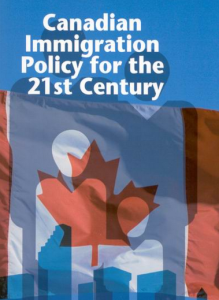 The new immigration policy of the 1920s, the Great Depression, and World War II caused there to be a dramatic decrease in immigration to Canada and the United States. After World War II, legislation allowed refugees and displaced persons from the war to immigrate to the United States and Canada. Both countries’ ideologies began to shift more towards egalitarian ideas such as welfare state and multiculturalism which implemented more tolerance towards people of different races and lead the charge against racial discrimination.[1] During the 1960s, the Civil Rights Movement lead to an increasing interest group for racial acceptance which fostered the new immigration policies implemented by the United States and Canada. (Talk about Great Society coalition of Jews, Catholics and Liberals as described in Mills) It was with these policies in which Canada decided to take a different route than that of the United States’.
The new immigration policy of the 1920s, the Great Depression, and World War II caused there to be a dramatic decrease in immigration to Canada and the United States. After World War II, legislation allowed refugees and displaced persons from the war to immigrate to the United States and Canada. Both countries’ ideologies began to shift more towards egalitarian ideas such as welfare state and multiculturalism which implemented more tolerance towards people of different races and lead the charge against racial discrimination.[1] During the 1960s, the Civil Rights Movement lead to an increasing interest group for racial acceptance which fostered the new immigration policies implemented by the United States and Canada. (Talk about Great Society coalition of Jews, Catholics and Liberals as described in Mills) It was with these policies in which Canada decided to take a different route than that of the United States’.
Whereas Canada’s immigration policy of today is geared towards a completely economical public policy stand point, the United States’ policy makers adhered to a more humanitarian approach. According to Borjas with regards to Canada, “According to Borjas, “the point system attempts to match immigrant skills with labor market needs and reduces the fiscal burden that immigration would place on Canada’s generous system of public assistance”[1]. This is then a clear cut way that Canada is trying to economically find a solution to the immigration debate. According to Borjas with regards to the United States, “At some point in the debate over any social policy, the facts have to be let out of their moral vacuum. And the facts have to be interpreted in the context of a set of beliefs, values, and a vision of what the United States is about”[2]. When talking about the immigration policy in the United States, Borjas describes the U.S. immigration policy as not just done for the quantitative, numeric, economic gains and losses, but there is also a moral context in which the policy adheres to. The United States is known as the land of opportunity and a country of immigrants. The United States is one of the most wealthy countries in our nation, so helping people who are less fortunate than them has become part of the moral fabric in the United States’ immigration debate. According to an article in the Economist, “in the United States, you rarely hear somebody advocate for immigration on the grounds that it adds to the social fabric of the country. When the normative argument arises here, it has a humanitarian dimension. I would posit that in the United States, identity is a right, not a value”[3]. This is the clear distinction between the way in which policy makers in the United States look at immigration and how policy makers in Canada look at immigration. The United States sees immigration to their country as a right to the immigrant whereas Canada looks at immigration as a value to their own country. According to Borjas the United States’ main immigration objective is to maximize the economic well-being of the native-born population[4]. If the United States really wanted to increase the economic efficiency of their immigration policy, wouldn’t they just follow Canada’s point system? Borjas mentioned in an earlier talk about the immigration of “high-skilled” labor from Russian mathematicians in 1992 that lead to basically a replacement of high skilled US mathematicians for only about 400 Russian mathematicians that ended up comprising of about 10% of the mathematics papers written in the United States at this time. However, Borjas’ conclusion, using a future regression model, was that if the Russians had not come at all, we would have had about the same amount of mathematics papers as we do today. So with the influx of low skilled labor and high skilled labor, these immigrations really have not done much for the economy at this point.